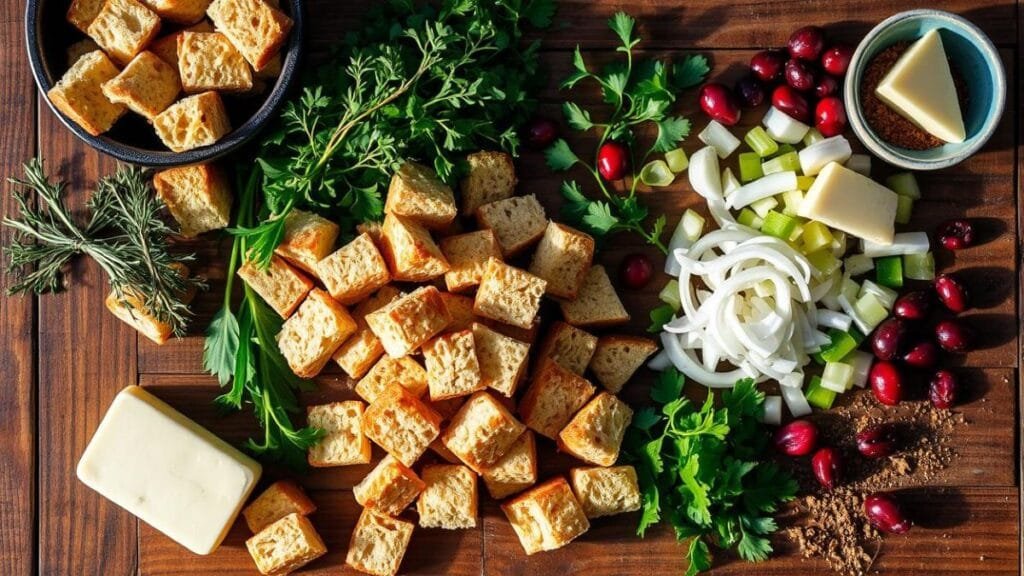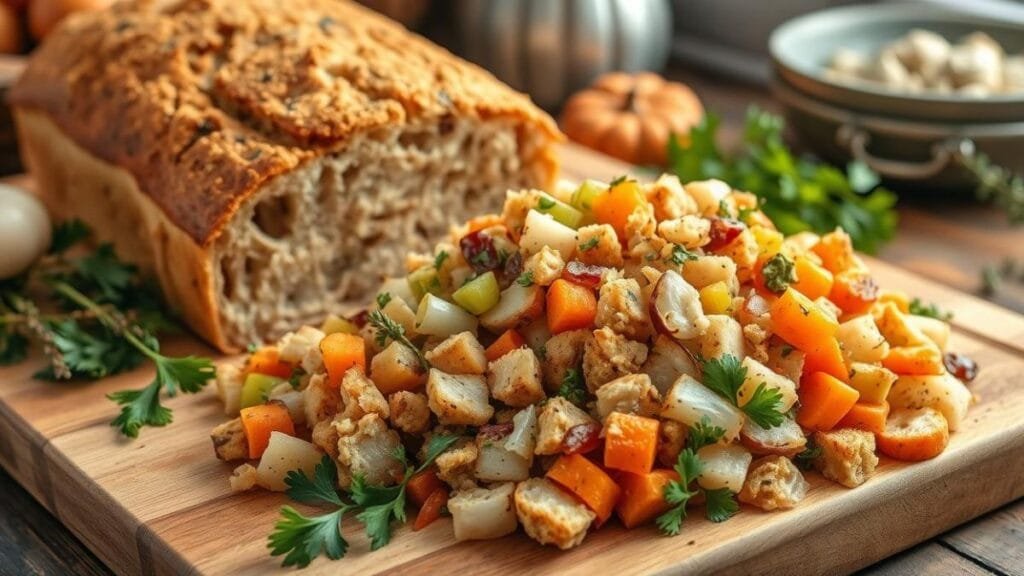Did you know one loaf of sourdough bread can make 12 cups of stuffing? This is enough for 14 guests at your holiday feast. My recipe will change your Thanksgiving side dish game with a tangy, flavorful twist.
Making the perfect sourdough bread stuffing is more than just ingredients. It’s about creating a culinary experience that brings families together. With just 20 minutes of prep and 45 minutes of cooking, you can make a mouthwatering stuffing for your holiday.
This guide will take you through every step of making an amazing sourdough bread stuffing. From picking the right sourdough loaf to mastering the perfect herb blend, I’ll share professional tips for a delicious result every time.
Whether you’re an experienced home cook or new to holiday cooking, this recipe is special. My method ensures a stuffing that’s crispy on top, moist inside, and full of rich, complex flavors. Your guests will ask for seconds.
Why Choose Sourdough Bread for Holiday Stuffing
I love cooking at home, and I’ve found that sourdough bread makes holiday stuffing special. It’s not just a side dish; it’s a memorable experience. Sourdough’s unique qualities make it perfect for festive meals.
Sourdough is more than just bread for stuffing. It’s full of nutrients and easy to digest. This makes it a great choice for those who care about what they eat.
Benefits of Sourdough in Stuffing
- Enhanced flavor complexity from natural fermentation
- Improved nutrient absorption through fermentation process
- Better digestibility for those with mild gluten sensitivities
- Reduced phytic acid content compared to regular bread
Texture and Flavor Advantages
The texture of stuffing is key. Sourdough’s crumb absorbs flavors well and stays firm. Its tangy taste adds a new layer to traditional stuffing.
Nutritional Benefits
| Nutritional Aspect | Sourdough Advantage |
|---|---|
| Probiotic Potentia | Fermentation process supports gut health |
| Mineral Availability | Reduced phytic acid increases nutrient absorption |
| Glycemic Impact | Lower blood sugar response compared to regular bread |
Choosing sourdough for your stuffing does more than just taste good. It enhances the whole meal with its flavor, texture, and health benefits.
Essential Ingredients for Perfect Sourdough Bread Stuffing
Making a tasty sourdough bread stuffing begins with top-notch ingredients. I love starting with homemade sourdough bread. Adding fresh herbs and the right mix of ingredients turns a simple side into a standout dish.
- Bread Base:
- 18-24 ounces of artisan sourdough bread (about 14 cups)
- Crusty, day-old bread is best for texture
- Aromatic Vegetables:
- 2 large yellow onions (about 3 cups), diced
- 5 celery ribs (2 cups), finely chopped
- 6 garlic cloves, minced
- Fresh Herbs Collection:
- 3 tablespoons fresh parsley
- 3 tablespoons fresh sage
- 2 tablespoons fresh rosemary
The right chicken stock makes a big difference in flavor. I always use homemade chicken stock for the best taste. It helps mix the ingredients and adds a rich flavor to the stuffing.
| Ingredient | Quantity | Purpose |
|---|---|---|
| Unsalted Butter | 1 cup | Brings richness and sautés vegetables |
| Chicken/Vegetable Broth | 2½ cups | Moistens and flavors the stuffing |
| Large Eggs | 2 | Binds the ingredients together |
Season with 1 teaspoon kosher salt and ½ teaspoon black pepper for extra flavor. Using homemade sourdough, fresh herbs, and the right ingredients makes a stuffing that wows your guests.

Preparing and Drying the Bread Cubes
Making perfect bread cubes is key to great stuffing. The right way to dry bread can make your holiday dish amazing. I’ll show you how to prepare and dry your bread cubes.
Choosing the right bread is important. Sourdough and white sandwich bread are great choices. Use a full loaf and cut it into 1-inch cubes with kitchen shears or a serrated knife.
Air-Drying Method
Air-drying is a classic way to dry bread cubes. Here’s how to do it:
- Spread bread cubes on a large baking sheet
- Leave at room temperature for 1-3 days
- Toss cubes occasionally to ensure even drying
- Avoid humid environments during drying
Oven-Drying Technique
Oven-drying is faster. Here’s what to do:
- Preheat oven to 200°F
- Spread bread cubes in a single layer
- Bake for 45-60 minutes
- Stir cubes halfway through drying
Pro tip: Keep an eye on your bread cubes to avoid burning. They should be crisp but not too dark.
Storage Tips
Storing your dried bread cubes right is important. Keep them in an airtight container at room temperature for up to a week. For longer storage, freeze them for months.
| Drying Method | Temperature | Time | Pros |
|---|---|---|---|
| Air-Drying | Room Temperature | 1-3 Days | No Energy Use, Natural Process |
| Oven-Drying | 200°F | 45-60 Minutes | Quick, Controlled Drying |
| Air Fryer | 300°F | 8-10 Minutes | Fastest Method, Crispy Texture |
Remember, dry bread cubes soak up flavors better and prevent soggy stuffing. Try these methods to find your favorite way to dry bread cubes!
Aromatics and Fresh Herbs Selection
Making the perfect sourdough stuffing begins with picking the best aromatics and herbs. The key to a great holiday side dish is using fresh ingredients. These ingredients make the bread’s flavors shine.
Here’s a classic mix of herbs and aromatics that adds depth to your stuffing:
- Fresh sage: A robust, earthy herb perfect for traditional stuffing
- Fresh thyme: Adds delicate, slightly minty undertones
- Onion: Provides a sweet and savory base
- Celery: Introduces a subtle crunch and fresh flavor
For your aromatics, use about 2 cups of diced onions and 1 cup of finely chopped celery. Sauté them in 1/4 cup of butter. This brings out their natural sweetness and adds a rich flavor to the stuffing.
| Herb Type | Fresh Quantity | Dried Quantity | Flavor Profile |
|---|---|---|---|
| Sage | 1/4 cup chopped | 2 tsp | Earthy, robust |
| Thyme | 2 TB | 1 tsp | Delicate, slightly minty |
| Rosemary | 1 TB | 1 tsp | Piney, strong |
| Parsley | 1/4 cup | 1 TB | Fresh, bright |
Pro tip: Always use fresh garlic (about 2 cloves) to enhance the aromatics. For an extra flavor boost, consider adding a 1/3 cup of dry white wine like chardonnay during the sautéing process. This technique helps deglaze the pan and infuse additional complexity into your sourdough stuffing.

Step-by-Step Cooking Process
Making stuffing is an art that needs careful preparation. I’ll show you how to make a tasty holiday side dish. It will impress your guests.
Vegetable Preparation
Begin by picking fresh vegetables for your stuffing. Use 2 cups of diced onions and 3 cups of diced celery. In a large skillet, melt 4 tablespoons of butter and sauté the vegetables until they’re soft and translucent, which takes about 5-7 minutes.
- Dice onions uniformly
- Chop celery into small, consistent pieces
- Use fresh herbs like sage and thyme for enhanced flavor
Combining Ingredients
When mixing ingredients, aim for layers of flavor. Mix the sautéed vegetables with 22 ounces of dried sourdough bread cubes in a large mixing bowl. Whisk 2 eggs with 2-3 cups of vegetable broth, then pour over the bread mixture.
Baking Instructions
To bake stuffing perfectly, put the mixture in a 9×13-inch baking dish. Cover with foil and bake at 350°F for 30 minutes. Then, uncover and bake for an additional 10-15 minutes until the top is golden brown and crispy.
| Nutrient | Amount per Serving |
|---|---|
| Calories | 289 kcal |
| Protein | 9g |
| Carbohydrates | 32g |
| Fat | 14g |
The result is a delicious sourdough stuffing for 12 people. It takes about 1 hour and 10 minutes to prepare. Let the stuffing rest for a few minutes before serving. This allows the flavors to meld perfectly.
Make-Ahead Tips and Storage Solutions
Preparing a make-ahead stuffing can be a game-changer for holiday meal planning. I’ve found smart ways to keep your sourdough bread stuffing fresh and tasty from start to finish.
Storing stuffing right is key. You can make it 1-2 days early without losing much quality. Here are my best tips for making stuffing ahead of time:
- Refrigerate unbaked stuffing in an airtight container
- Let stuffing come to room temperature before baking
- Add extra broth before baking to prevent dryness
Freezing is also great for keeping stuffing for longer. You can freeze unbaked stuffing for up to 3 months. This is perfect for those who are always busy.
| Storage Method | Duration | Recommended Action |
|---|---|---|
| Refrigerated (Unbaked) | 1-2 days | Bring to room temperature, add broth, bake |
| Frozen (Unbaked) | Up to 3 months | Bake directly from frozen, extend cooking time |
| Refrigerated (Baked) | 3-4 days | Reheat covered in oven |
When reheating stuffing, be gentle to keep it soft. Always use the oven, not the microwave. Cover the dish with foil and warm at 350°F for 15-20 minutes.
- Pro tip: Sprinkle a bit of extra broth before reheating to restore moisture
- Never reheat stuffing more than once to preserve food safety
By using these storage tips, your sourdough bread stuffing will stay delicious from start to finish.

Recipe Variations and Dietary Adaptations
Making tasty stuffing for different diets is simpler than you think. I’ll show you how to turn your sourdough stuffing into vegetarian, vegan, and other tasty versions. These ideas will make everyone happy.
It can be tough to cook for guests with different diets. But, sourdough bread stuffing is very flexible. You can easily make it fit many dietary needs.
Vegetarian Options
For a vegetarian stuffing, just swap chicken broth for vegetable broth. This keeps the dish savory without meat.
- Use mushroom stock for extra umami depth
- Select low-sodium vegetable broth to control salt content
- Experiment with herb-infused vegetable stocks
Add-in Suggestions
Make your stuffing even better with these tasty additions:
- Sautéed mushrooms for earthy flavor
- Chopped apples for sweetness
- Dried cranberries for tartness
- Toasted nuts like pecans or walnuts
Broth Alternatives
Choosing the right broth can change your vegan stuffing a lot. Try these options:
- Mushroom stock for intense flavor
- Herb-infused vegetable broth
- Homemade vegetable stock
For vegan stuffing, use olive oil instead of butter and skip the eggs. The texture might be different, but it’s just as tasty.
Conclusion
Making the best sourdough stuffing turns a simple side dish into a special treat. It’s all about finding the right mix of ingredients and techniques. From picking a great sourdough loaf to making a tasty stuffing, it takes time and care.
My way of making stuffing is all about adding your own twist while keeping it traditional. You can make it in 40 minutes and cook it in an hour. It’s perfect for adding something special to your meal. You can also change it up to suit everyone’s tastes, from veggies to herbs.
Each serving of this stuffing is a cozy 223 calories of flavor. It’s made with mushrooms, herbs, and sourdough bread. It’s sure to wow your guests and become a holiday favorite. With the tips from this guide, you’ll make a stuffing that’s the star of the show.
People love this recipe, with 56 shares on Facebook and Pinterest. It shows that everyone wants a delicious side dish. Whether you’re experienced or new to cooking, this sourdough stuffing is a treat for all.
FAQ
Can I use store-bought sourdough bread for stuffing?
Absolutely! Store-bought sourdough bread works great. Look for a bread with a crusty outside and soft inside. This helps it soak up the stuffing’s moisture well.
How do I prevent my stuffing from becoming too dry or too soggy?
Dry the bread cubes well. You can air-dry them for 1-3 days or use the oven at 200°F for 1-2 hours. Add liquid slowly and let the bread soak for 10 minutes. The stuffing should be moist but not too wet. Cover it while baking and then uncover to crisp the top.
Can I make sourdough stuffing ahead of time?
Yes! Prepare the stuffing 1-2 days in advance and refrigerate it. Let it come to room temperature before baking. You can also freeze it for up to 3 months. Just bake it a bit longer if it’s frozen.
Is sourdough stuffing good for people with gluten sensitivities?
Sourdough bread might be easier to digest for some with gluten sensitivities. But, it’s not safe for those with celiac disease. For a gluten-free option, look for special breads.
What are some good variations to traditional sourdough stuffing?
There are many tasty variations! Add sautéed mushrooms, chopped apples, or dried cranberries. Try toasted nuts or cooked sausage for a heartier stuffing. For vegetarians, add more veggies or plant-based proteins. Experiment with herbs and use vegetable broth instead of chicken broth.
How long can I store leftover baked stuffing?
Store leftover stuffing in the fridge for 3-4 days or freeze for 2 months. Reheat it covered in the oven. Avoid microwaving to keep it from getting soggy.
Can I make a vegan version of sourdough stuffing?
Yes! Use olive oil instead of butter and vegetable broth instead of chicken broth. Flax eggs or more broth can replace eggs. The texture might be a bit different.














